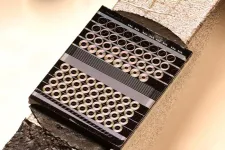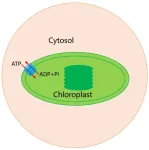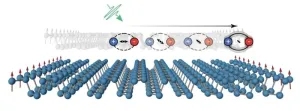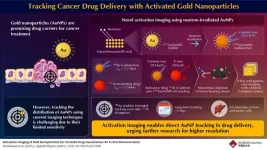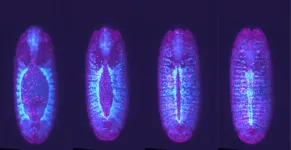(Press-News.org)
Delft, The Netherlands: Quantum Internet Alliance (QIA) researchers at TU Delft, QuTech, University of Innsbruck, INRIA and CNRS recently announced the creation of the first operating system designed for quantum networks: QNodeOS. The research, published in Nature, marks a major step forward in transforming quantum networking from a theoretical concept to a practical technology that could revolutionize the future of the internet.
“The goal of our research is to bring quantum network technology to all. With QNodeOS we're taking a big step forward. We're making it possible – for the first time – to program and execute applications on a quantum network easily”, says Prof. Dr. Stephanie Wehner, Professor of Quantum Computer Science at TU Delft’s quantum technology research institute QuTech who led the study. “Our work also creates a framework opening entirely new areas of quantum computer science research.”
Lowering barriers for developers
The ability to easily program classical computing hardware such as laptops or phones has had a transformative impact on our world and enabled the creation of a wide range of applications. “The system is like the software on your computer at home: you don’t need to know how the hardware works to use it,” says Mariagrazia Iuliano, PhD student at QuTech.
By essentially removing the barrier between networking hardware and software, the operating system will allow developers to create applications with ease and across a large spectrum of hardware solutions, paving the way for the development of software that can bring quantum network technology to society.
A fully programmable operating system
The quantum network operating system, known as QNodeOS, is fully programmable, meaning that applications can be run at a high level, just like on classical operating systems such as Windows or Android. Unlike previous systems, which required coding specific to each experimental setup, QNodeOS makes it possible to operate quantum processors on a network with ease, regardless of the hardware platform used. “Such an architecture, which has never been created before for quantum networks, enables developers to focus on application logic rather than hardware details,” explains Bart van der Vecht, PhD student at QuTech. “This makes it easier to come up with new kinds of applications, some of which we may not even be able to imagine today.”
Compatible with multiple types of hardware
Quantum network applications differ from applications that run on a quantum computer, introducing unique challenges that the researchers had to overcome. Unlike quantum computers that run single programs, quantum network applications require separate programs to execute independently at different network nodes—like a client app on your phone and a server in the cloud. These programs must coordinate with each other through messages and quantum entanglement, a special type of quantum connection which gives quantum networks their power. QNodeOS solves the unique challenges posed by this different quantum execution paradigm.
The researchers demonstrated that QNodeOS can work with multiple types of quantum hardware, by connecting it to two very different types of quantum processors. “Our trapped ion processors work fundamentally differently than those based on color centers in diamond, yet we have shown QNodeOS can work with both of them”, says Tracy Northup, Professor at the University of Innsbruck, Austria.
The future of quantum networks
The creation of QNodeOS united experts from physics, computer science, and engineering in taking an important step in QIA's mission to build a scalable and useful quantum network that can support real-world applications. On this journey, the operating system will offer a crucial framework for continued study and experimentation.
As a next step, QIA is working to provide the world access to the technology’s software and hardware components. One of the ways to do this will be to employ QNodeOS on the Quantum Network Explorer, QuTech's quantum internet demonstrator. This will enable a far broader audience to experiment, innovate and create software for quantum networks, accelerating the evolution of the field.
To learn more about the research, visit Nature.
END
Our brains use basic ‘building blocks’ of information to keep track of how people interact, enabling us to navigate complex social interactions, finds a new study led by University College London (UCL) researchers.
For the study, published in Nature, the researchers scanned the brains of participants who were playing a simple game involving a teammate and two opponents, to see how their brains were able to keep track of information about the group of players.
The scientists found that rather ...
ANN ARBOR—Large, undisturbed forests are better for harboring biodiversity than fragmented landscapes, according to University of Michigan research.
Ecologists agree that habitat loss and the fragmentation of forests reduces biodiversity in the remaining fragments. But ecologists don't agree whether it's better to focus on preserving many smaller, fragmented tracts of land or larger, continuous landscapes. The study, published in Nature and led by U-M ecologist Thiago Gonçalves-Souza, comes to a conclusion on the decades-long debate.
"Fragmentation is bad," said study author Nate Sanders, U-M professor of ecology and evolutionary biology. ...
Modern communication networks rely on optical signals to transfer vast amounts of data. But just like a weak radio signal, these optical signals need to be amplified to travel long distances without losing information. The most common amplifiers, erbium-doped fiber amplifiers (EDFAs), have served this purpose for decades, enabling longer transmission distances without the need for frequent signal regeneration. However, they operate within a limited spectral bandwidth, restricting the expansion of optical networks.
To meet the growing demand for high-speed data transmission, researchers have been seeking ways to develop more powerful, flexible, ...
A recent study by Chinese scientists has revealed the intricate molecular machinery driving energy exchange within chloroplasts, shedding light on a key event in the evolution of plant life. Led by FAN Minrui from the Center for Excellence in Molecular Plant Sciences of the Chinese Academy of Sciences, the research elucidates the structure and function of the ATP/ADP translocator—a crucial member of the nucleotide transporter (NTT) family of proteins—which facilitates the transfer of energy across chloroplast membranes.
Their findings were published online in ...
Scientists have long suspected that phosphorene nanoribbons (PNRs) – thin pieces of black phosphorus, only a few nanometres wide – might exhibit unique magnetic and semiconducting properties, but proving this has been difficult. In a recent study published in Nature, researchers focused on exploring the potential for magnetic and semiconducting characteristics of these nanoribbons. Using techniques such as ultrafast magneto-optical spectroscopy and electron paramagnetic resonance they were able to demonstrate the magnetic behaviour of PNRs at room temperature, and show how these magnetic properties can interact with light.
The ...
HOUSTON ― The University of Texas MD Anderson Cancer Center’s Research Highlights showcases the latest breakthroughs in cancer care, research and prevention. These advances are made possible through seamless collaboration between MD Anderson’s world-leading clinicians and scientists, bringing discoveries from the lab to the clinic and back.
Study offers insights into evolutionary process driving pancreatic cancer
Read summary | Read study in Nature
Pancreatic cancer is hard to treat because ...
Gold nanoparticles (AuNPs) are tiny gold particles of 1–100 nanometers and have unique chemical and biological properties. Due to their potential to accumulate in tumors, these nanoparticles have emerged as promising drug carriers for cancer therapy and targeted drug delivery. However, tracking the movement of these nanoparticles in the body has been a major challenge. Traditional imaging methods often involve tracers like fluorescent dyes and radioisotopes, which give limited visualization and inaccurate results due to detachment from AuNPs.
In a step to advance the imaging of AuNPs, researchers from Waseda ...
SAN ANTONIO — March 12, 2025 — Four small suitcase-sized spacecraft, designed and built by Southwest Research Institute headquartered in San Antonio, launched from Vandenberg Space Force Base in California on March 11. NASA’s Polarimeter to Unify the Corona and Heliosphere, or PUNCH, constellation has spread out in a low-Earth orbit along the day-night line, providing a clear view in all directions for its two-year primary mission.
“The PUNCH spacecraft are now drifting into perfect position to study the solar corona, the Sun’s outer ...
In developing hearts, cells shuffle around, bumping into each other to find their place, and the stakes are high: pairing with the wrong cell could mean the difference between a beating heart and one that falters. A study publishing on March 12 in the Cell Press journal Biophysical Journal demonstrates how heart cells go about this “matchmaking” process. The researchers model the intricate movements of these cells and predict how genetic variations could disrupt the heart development process in fruit flies.
In both humans and fruit flies, the heart’s tissues arise from two distinct regions of ...
Study compares those with food insecurity to food-secure individuals over 20 years
Food insecurity is associated with a 41% increased risk of heart disease over time
Findings suggest food security screening as a key tool to prevent heart disease
CHICAGO --- Struggling to afford food today could mean heart problems tomorrow. Young adults experiencing food insecurity have a 41% greater risk of developing heart disease in midlife, even after accounting for demographic and socioeconomic factors, according to a new Northwestern Medicine study. Food insecurity — struggling to get enough nutritious ...



